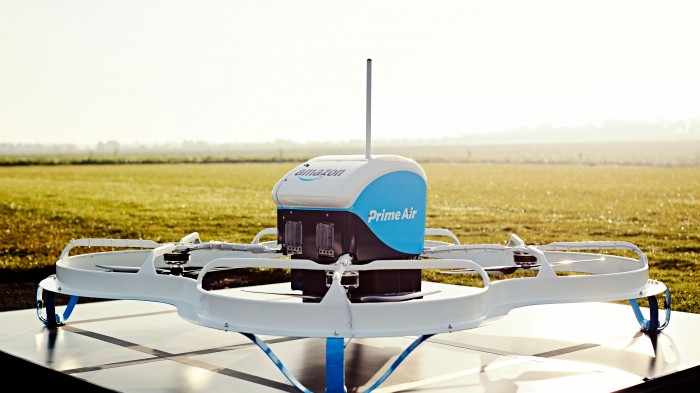Amazon’s Vision of Drone Deliveries Now Involves Parachutes

What goes up, must … then drop a parcel from a great height.
That’s apparently what engineers at Amazon think could happen with its much-touted delivery drones. While the e-commerce giant has already delivered packages to paying customers in the U.K. using its aircraft, it did so by landing in a large patch of open ground. Now, in a patent, it has outlined how it could drop packages from the air instead.
The patent describes a way to reliably eject a payload from a drone in midflight. Usually, such a drop would see the package descend along a parabolic arc, caused by the forward motion of the aircraft—but that might not jive too well with the neighbors. Instead, Amazon's idea is to apply a force as the package leaves the drone to have it descend vertically.
It also suggests that the package container could have some simple built-in method of correcting its descent. It may, for instance, feature aileron-like flaps that can tweak its course, with instructions relayed wirelessly from the drone above.
Amazon isn’t the only company to think that dropping parcels from the air without a motor is a good idea. The San Francisco-based startup Otherlab recently unveiled its own disposable cardboard drones, which glide a payload to their destination once dropped from a larger mother ship.
But for all these bright ideas, regulations still stand in the way of drone delivery in most parts of the world—that’s why Amazon is testing the idea in rural England, after all. Until that changes, the only parcel drop you’re going to get is from the height of your mailbox.
(Read more: USPTO, “These Paper Drones Are Built for One-Way Missions,” “An Amazon Drone Has Delivered Its First Products to a Paying Customer,” "U.K. Signs a Deal with Amazon to Test Delivery Drones")
Keep Reading
Most Popular
Large language models can do jaw-dropping things. But nobody knows exactly why.
And that's a problem. Figuring it out is one of the biggest scientific puzzles of our time and a crucial step towards controlling more powerful future models.
How scientists traced a mysterious covid case back to six toilets
When wastewater surveillance turns into a hunt for a single infected individual, the ethics get tricky.
The problem with plug-in hybrids? Their drivers.
Plug-in hybrids are often sold as a transition to EVs, but new data from Europe shows we’re still underestimating the emissions they produce.
Google DeepMind’s new generative model makes Super Mario–like games from scratch
Genie learns how to control games by watching hours and hours of video. It could help train next-gen robots too.
Stay connected
Get the latest updates from
MIT Technology Review
Discover special offers, top stories, upcoming events, and more.